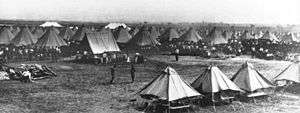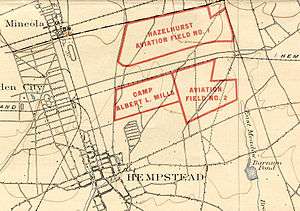Camp Mills
Camp Albert L. Mills (Camp Mills) was a military installation on Long Island, New York. It was located about ten miles from the eastern boundary of New York City on the Hempstead Plains within what is now the village of Garden City. It was named in honor of Major General Albert L. Mills, who was awarded the Medal of Honor for gallantry during the Spanish–American War.
| Camp Mills Aviation Concentration Center | |
|---|---|
| Garden City,[1] Long Island, New York | |
 Encampment of National Guard soldiers at Camp Mills, New York training for service in World War I | |
 Location of Camp Mills. Note location of Hazelhurst Field and Aviation Field #2, later becoming Mitchel Field | |
| Coordinates | 40°43′32″N 73°36′58″W |
| Site history | |
| Built | 1917 |
Camp Mills was one of three camps under control of the New York Port of Embarkation with a capacity for 40,000 transient troops.[2] The facility was one of several military establishments built during World War I in the Mineola, New York area that included the Aviation General Supply Depot and Concentration Camp; Hazelhurst Field (later Roosevelt Field) and Mitchel Field.
History
The mission of Camp Mills was initially the preparation of Army units prior to their deployment to Europe in World War I. It was established as temporary tent camp in September 1917 as a place to mobilize the 42nd Division, made up of National Guard units from various states. After the 42d left for the Western Front in France, the 41st Division followed, occupying the camp from October to November 1917. It was then ordered to be abandoned, but reestablished April 4, 1918, as a part of the New York Port of Embarkation at Hoboken, New Jersey to obtain additional facilities for troops in transit to Europe.
.png)
Camp Mills was expanded to a containment with wooden buildings for the accommodation of thousands of troops, who arrived from training camps across the United States. At Camp Mills the units waited until they could be scheduled for embarkation whereupon they would travel by trains of the Long Island Rail Road to board ferryboats for the overseas piers in Brooklyn or Hoboken and loaded onto troop ships.[2] Those ships transported troops primarily to the ports of Liverpool, England, or Brest, France. Facilities at Camp Mills included a hospital, warehouses, bakery, delousing plant and other facilities. It eventually consisted of about 1,200 buildings with a capacity of 46,000, including space for 40,000 transients (about half in barracks, half in tents), a 500 inmate detention camp and 5,500 members of a permanent garrison. A very large number of American soldiers shipped out to France from Camp Mills, at its peak in September 1918, over 31,000 troops were stationed there. Notable individuals who were assigned during World War I were: Douglas MacArthur, Wild Bill Donovan, Joyce Kilmer and Father Duffy among them. F. Scott Fitzgerald was a soldier at Camp Mills.
With the end of World War I in November 1918, Camp Mills then performed a mission to process the thousands of troops back into the United States as a demobilization center. Many returning units passed through it and were either demobilized or sent to other camps across the United States where the men were processed out of the Army and returned to civilian life.
With the last troops returning from Europe during the summer of 1919, the camp was ordered to be abandoned and sold, although operations continued until March 31, 1920, when garrison troops were transferred elsewhere. In 1938 Camp Mills was incorporated into Mitchel Field as part of an Air Corps expansion.
Aviation Concentration Center
The Aviation General Supply Depot and Concentration Camp (Garden City) was a temporary wartime establishment located adjacent to Camp Mills, and shared many of its facilities. It was used for organizing, training, and equipping Air Service troops. Also originally a tent camp, it was established on 17 August 1917 to facilitate Air Service units for the purposes of embarkation to Europe, and after the armistice in November 1918, for the purposes of debarkation. The facility was later expanded with wooden buildings and turned into a containment.
The Concentration Center was under the jurisdiction of the Operations Section, Department of Military Aeronautics. It was later re-designated as the Air Service Depot from October 1918 to April 1919 when it was consolidated with Hazelhurst Field and made part of Mitchel Field on 5 April 1919.
Present-day
Today, Camp Mills and the Aviation Concentration Center are a part of the urban community of the village of Garden City, and are totally unrecognizable from the urban area. A monument to the Rainbow Division (42nd) at St James Street and Rainbow Place in Garden City near the site of Camp Mills was restored and then rededicated on November 11, 2004.
References
- Hofstra University Library Special Collections, Camp Mills Photographs http://www.hofstra.edu/pdf/Library/libspc_Camp_Mills_Finding_Aid.pdf Archived 2015-04-16 at the Wayback Machine
- Huston, James A. (1966). The Sinews of War: Army Logistics 1775–1953. Army Historical Series. Washington, DC: Center Of Military History, United States Army. pp. 346–347. LCCN 66060015. Retrieved 23 October 2014.
Further reading
- Order of Battle of the United States Land Forces in the First World War, Volume 3, Part 2, Center of Military History, United States Army, 1949 (1988 Reprint), Zone of the Interior, Territorial Departments, Tactical Divisions organized in 1918. Posts, Camps and Stations.
- Triplet, William S. (2000). Ferrell, Robert H. (ed.). A Youth in the Meuse-Argonne. Columbia, Mo.: University of Missouri Press. pp. 28-30, 68. ISBN 0-8262-1290-5. LCCN 00029921. OCLC 43707198.
- Swanson, Robert Domestic United States Military Facilities of the First World War, 1917–1919